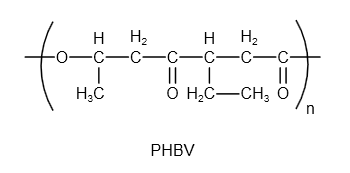
Poly\[ - \beta - \]hydroxybutyrate-co\[ - \beta - \]hydroxy valerate (PHBV) is a copolymer of:
A. \[3 - \]hydroxybutanoic acid and \[4 - \]hydroxypentanoic acid
B. \[2 - \] hydroxybutanoic acid and \[3 - \]hydroxypentanoic acid
C. \[3 - \] hydroxybutanoic acid and \[2 - \]hydroxypentanoic acid
D. \[3 - \] hydroxybutanoic acid and \[3 - \]hydroxypentanoic acid
Answer
124.8k+ views
Hint: Polymer is a substance or material made up of very large molecules or macromolecules made up of numerous repeating subunits. Natural and manmade polymers both play important parts in our daily lives due to their broad spectrum. Polymers are crucial to biological structure and function, ranging from synthetic plastics such as polystyrene to natural polymers and natural biopolymers such as protein and DNA.
Complete Step by Step Solution:
PHBV stands for Poly\[ - \beta - \]hydroxybutyrate-co\[ - \beta - \]hydroxyvalerate. It is a polyhydroxyalkanoate polymer of some sort. It is a non-toxic natural biodegradable plastic made by bacteria that can be utilised as an alternative to synthetic polymers.
The structure of PHBV is as follows:

Image: Structure of PHBV
Two (or more) types of monomer units are used to make a copolymer. Two (or more) types of monomer units can be found in the copolymer's repeating structural unit.
PHBV is prepared by the reaction as follows:

Image: Reaction to prepare PHBV
Therefore, PHBV is a copolymer of \[3 - \] hydroxybutanoic acid and \[3 - \]hydroxypentanoic acid.
Additional Information: Many bacteria, such as Paracoccus denitrificans, generate it naturally, and many genetically altered plants can also produce it. PHBV is a brittle thermoplastic polymer with poor elongation at break and limited impact resistance.
Note: Because of the geometry of the f-orbitals, the elements near the bottom of the group have f-subshell electrons that are diffused. They successfully shelter the s-electrons from the nucleus's attraction and render them bonding inactive.
Complete Step by Step Solution:
PHBV stands for Poly\[ - \beta - \]hydroxybutyrate-co\[ - \beta - \]hydroxyvalerate. It is a polyhydroxyalkanoate polymer of some sort. It is a non-toxic natural biodegradable plastic made by bacteria that can be utilised as an alternative to synthetic polymers.
The structure of PHBV is as follows:

Image: Structure of PHBV
Two (or more) types of monomer units are used to make a copolymer. Two (or more) types of monomer units can be found in the copolymer's repeating structural unit.
PHBV is prepared by the reaction as follows:

Image: Reaction to prepare PHBV
Therefore, PHBV is a copolymer of \[3 - \] hydroxybutanoic acid and \[3 - \]hydroxypentanoic acid.
Additional Information: Many bacteria, such as Paracoccus denitrificans, generate it naturally, and many genetically altered plants can also produce it. PHBV is a brittle thermoplastic polymer with poor elongation at break and limited impact resistance.
Note: Because of the geometry of the f-orbitals, the elements near the bottom of the group have f-subshell electrons that are diffused. They successfully shelter the s-electrons from the nucleus's attraction and render them bonding inactive.
Recently Updated Pages
Classification of Drugs Based on Pharmacological Effect, Drug Action

Types of Solutions - Solution in Chemistry

Difference Between Alcohol and Phenol

JEE Main Participating Colleges 2024 - A Complete List of Top Colleges

JEE Main Maths Paper Pattern 2025 – Marking, Sections & Tips

Sign up for JEE Main 2025 Live Classes - Vedantu

Trending doubts
JEE Main 2025 Session 2: Application Form (Out), Exam Dates (Released), Eligibility & More

JEE Main Exam Marking Scheme: Detailed Breakdown of Marks and Negative Marking

JEE Main 2023 January 24 Shift 2 Question Paper with Answer Keys & Solutions

Learn About Angle Of Deviation In Prism: JEE Main Physics 2025

JEE Main 2025: Conversion of Galvanometer Into Ammeter And Voltmeter in Physics

JEE Main Login 2045: Step-by-Step Instructions and Details

Other Pages
NCERT Solutions for Class 12 Chemistry Chapter 6 Haloalkanes and Haloarenes

JEE Advanced Marks vs Ranks 2025: Understanding Category-wise Qualifying Marks and Previous Year Cut-offs

NCERT Solutions for Class 12 Chemistry Chapter 1 Solutions

NCERT Solutions for Class 12 Chemistry Chapter 2 Electrochemistry

NCERT Solutions for Class 12 Chemistry Chapter 8 Aldehydes Ketones and Carboxylic Acids

NCERT Solutions for Class 12 Chemistry Chapter 9 Amines




